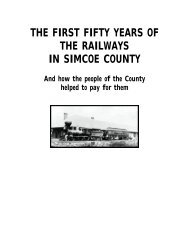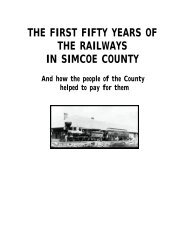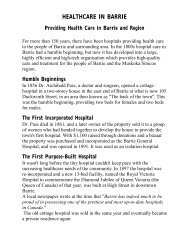xx Barrie's Sidewheeler
Create successful ePaper yourself
Turn your PDF publications into a flip-book with our unique Google optimized e-Paper software.
BARRIE'S SIDEWHEELER<br />
THE STEAMSHIP IDA BURTON
As a steamer of the 1860s and 1870s on Lakes Simcoe and<br />
Couchiching, the Ida Burton was quite big and quite fast.<br />
Her ties with Barrie were due to her being built there and<br />
her being operated from there.<br />
Her owners were businessmen of Barrie, although they were<br />
an Allandale family (at that time Allandale was still separate<br />
from Barrie).<br />
She lasted only nine years or so and does not have a place in<br />
the "Barrie Hall of Fame", but in her time she was a wellknown<br />
feature of the scene on Lakes Simcoe and<br />
Couchiching,<br />
(Brian Perkins 2016)
<strong>Barrie's</strong> <strong>Sidewheeler</strong><br />
Lake Simcoe and the first Steamship<br />
For the better part of the 19th century Lake Simcoe played a major role in<br />
the development of what became Central Ontario.<br />
In 1832, there was only a handful of settlers among the Indians of "The<br />
Narrows Village" at what became Orillia. With them were some<br />
enterprising half-pay British naval and military officers, who had settled<br />
along the shores of Lake Simcoe. They formed what today would be<br />
called a syndicate, to finance and build the first steamer on lakes not<br />
connected to rivers running to the ocean. They named their 90-foot ship<br />
"The Sir John Colborne" after the lieutenant-governor of the day. She was<br />
slow (just four miles per hour), built on a schooner hull; and was the<br />
ninth steamship built in Canada. The ship was built without the expertise<br />
of marine architects, and only 16 years after the first Canadian-built<br />
steamship, the SS Frontenac, slid into the Bay of Quinte waters off<br />
Kingston.<br />
These men may have settled far from the centres of commerce in Upper<br />
Canada, but they were very much in touch with spirit of the times.<br />
Although "The Sir John Colborne" was a commercial failure she was the<br />
forerunner of the steamships which were to ply Lake Simcoe. The era of<br />
the steamship on Lake Simcoe thus began.<br />
Before the coming of rail and road networks, water provided the quickest,<br />
most comfortable, and most efficient means of transportation in Upper<br />
Canada. Originally the boats plying the lake were canoes, bateaux (large,<br />
flat-bottomed row-boats measuring nearly 50 feet, in length), and sailing<br />
schooners.<br />
Rise of the Steamships<br />
Eventually steamships replaced these earlier modes of travel/ Many of<br />
them were handsome vessels that enjoyed long and successful careers.
In the mid-1800s waterways were the highways until railways and roads<br />
spread across central Ontario. Compared with what had gone before,<br />
travel was economical, quick and relatively comfortable aboard<br />
steamships crossing Lake Simcoe ferrying mail, freight and settlers to<br />
outlying settlements. They were vital to the survival and growth of towns<br />
supplying farm goods and lumber to railheads destined for distant<br />
markets. Not only utilitarian, they also provided an element of romance.<br />
Steamships were relatively easy to build and did not require special drydocks<br />
or slips, so around the lake many communities - some little more<br />
than villages - built them. The Ida Burton was one such steamship.<br />
The Ida Burton<br />
The Ida Burton was only one of many vessels on Lake Simcoe, but she<br />
had the distinction of being the first steamship built in Barrie, and the<br />
last side-wheeler built on either Lakes Simcoe or Couchiching. The Ida<br />
Burton became one of the most successful steamships of the day.<br />
She was a wooden ship, with large paddle wheels midway between stern<br />
and bow, and was built at a time when steamship travel on Lake Simcoe
was nearing its end. The Ida Burton was launched on June 13, 1866, by<br />
George Burton and his partner Llewellyn Oliver.<br />
She was a twin-deck wooden vessel, 82 feet long with a beam of 14 feet.<br />
Steam power came from a single cylinder fed from a single boiler.<br />
George Burton was the son of lumber magnate William Burton. Llrwellyn<br />
Oliver was the county coroner, a distinguished doctor, and a dabbler in<br />
various business interests.<br />
The pride of the Lake Simcoe fleet was named after Ida, the mother of<br />
George Burton's sons James Lindsay (1848 to 1910) and Martin (1852 to<br />
1914). These two men were among the most prominent businessmen in<br />
19th century Barrie. Together they had a hand in most of the large<br />
industries in town and owned nearly half of the nearby village of<br />
Allandale (now a part of Barrie). James Lindsay occupied most of his<br />
time with the Northern Navigation Company, whose fleet steamed across<br />
the waters of Georgian Bay, Lake Simcoe, and Lake Couchiching,<br />
delivering mail, cargo, and passengers.<br />
Because Barrie wasn’t a major port, or even a particularly notable<br />
community until mid-century, the Ida Burton was the only side-wheeler<br />
the Burton’s (or anyone else) ever built there. Trains had cornered the<br />
shipping market by the time the rails reached Barrie in the early 1850s.<br />
The town accordingly lost its reliance on water transportation, but other<br />
communities not directly served by rail continued to build ships.<br />
For nearly a decade, from 1866 to 1875, the Ida Burton left Barrie with<br />
travelers arriving by train from Toronto bound for luxury hotels on the<br />
Muskoka Lakes. The first stop was at Orillia, then across the length of<br />
Lake Couchiching for connection with the Northern Railway. From this<br />
railhead at Washago, on the Severn River, travellers rode the rails to<br />
Gravenhurst where they boarded another steamer for the final part of their<br />
journey.<br />
The Ida Burton was hired for private functions at a time when the<br />
temperance movement was having some success in reducing alcohol sales
in Ontario. Consuming alcohol was often frowned upon, especially<br />
among the well-heeled “upstanding” citizens. However, private<br />
excursions aboard the Ida Burton were rarely dry, and were used as<br />
opportunities to indulge in alcohol away from prying eyes. Parties,<br />
complete with musical entertainment, were often the highlight of the<br />
summer social season.<br />
George Burton didn't enjoy her success for long. He drowned in Lake<br />
Simcoe on June 10, 1869. He was only 33 years old.<br />
After his death, the Ida Burton was taken over by sons Martin and James<br />
Lindsay.<br />
Though she continued for a time in the passenger trade, the steamship's<br />
fortunes were undermined when the Northern railway was extended to<br />
Gravenhurst. She was increasingly utilized as part of the Burton Brothers'<br />
industrial business by towing logs from timber camps around the lakes to<br />
their sawmill at Barrie.<br />
End of the Ida Burton<br />
In 1875, the Ida Burton was badly damaged in a collision with another<br />
vessel. With their timber fortunes now being made at Byng Inlet on<br />
Georgian Bay, there was no real reason for the Burtons to rebuild their<br />
steamship, so she remained moored along the Barrie docks.<br />
Her end came a year later when her machinery was removed for sale and<br />
she was taken to Orillia and ignominiously sunk at the lakeshore to serve<br />
as the foundation of a wharf. She lies there still,<br />
The steamship’s passing wasn't much of a setback for the Burton<br />
brothers, who went on to help found the Barrie Electric Light Company<br />
and other enterprises. Martin also went into the lumber business in a big<br />
way. With extensive timber rights and a huge mill at Byng Inlet along<br />
Georgian Bay, he became one of the wealthiest lumber barons in Ontario.<br />
James Lindsay devoted much of his later years to local politics, serving<br />
many years as deputy reeve of Barrie and then as reeve from 1889 to<br />
1890.
************************************<br />
The Burton family name lives on in Burton Avenue in Allandale, but their<br />
steamship Ida Burton has been forgotten and what remains of her lies<br />
beneath the waters at the shore of of Lake Couchiching.<br />
Brian Perkins (2016)<br />
**************************************













